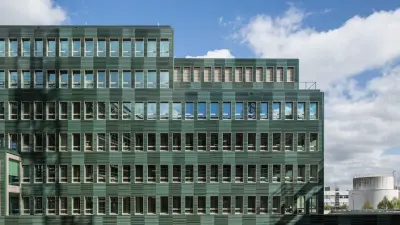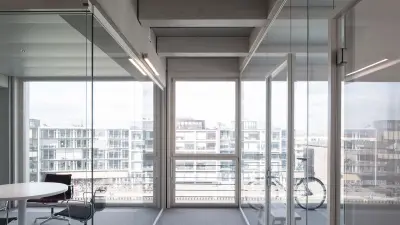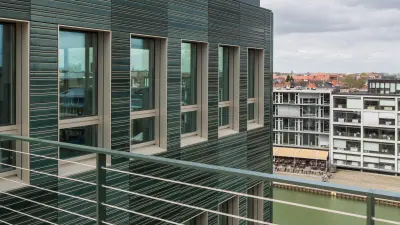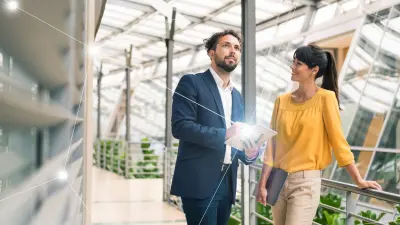Made of sterner stuff
With its wood and its sensors, H7 Munster gives us a vision of true sustainability. It succeeds in doing so not only because the building was designed and built to be energy efficient, but because it was also designed for sustainable operation.
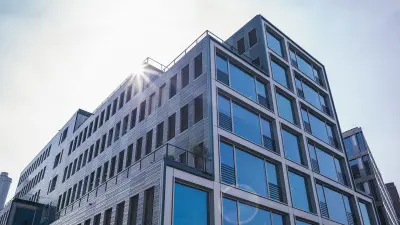
North Rhine-Westphalia’s largest hybrid timber building in Münster’s harbor district is a real feast for the eyes
Over seven floors, the 25-meter-high office and administration building houses a total of twelve rental units on an overall area of around 4,500 square meters, along with an underground parking garage about 2,400 square meter s in size. In German, the name H7 is self-explanatory – the H stands for ‘Holz’ or timber, and the 7 stands for the seven floors.
Sustainability as a program
Ambitious ecological goals were set for the building during the planning stage, which is not surprising since H7 was first intended as a home to the corporate headquarters of an organic supermarket. In line with the corporate philosophy of this anchor tenant, the aim was to implement high standards in building biology. The objective was per fectly clear: to produce as few pollutants as possible while striving for low energy consumption. For reasons of sustainability, the architects at Heupel GmbH decided on timber as their primary construction material. This done, there was still one particular hurdle to overcome: under building laws that applied in North Rhine-Westphalia up until that point, timber buildings could only be permitted if they were built with a maximum of three full stories. However, after the concept for a hybrid timber building proved to be both feasible and safe, the building permit was issued and, ultimately, there was nothing standing in the way of the sustainable building plans. Because this innovative office and commercial building had to satisfy much more stringent requirements – due to its main building material – special attention was paid to fire protection. The solution: all load-bearing timber components were made stronger than statically necessary so that they could theoretically withstand a fire lasting for 90 minutes.
Design meets an optimized energy balance
While the white-glazed spruce timber that was used as a load-bearing element adds a lot of warmth to the building, the core structures for the stairwells and elevators, made of reinforced concrete, offer an exciting contrast. The front facades of the building are made of glass, providing a view of the goings-on in Münster’s harbor. Green glazed tiles on the facade perfectly match the timber, lending an architectural accent to the building’s ecological theme. Energy efficiency measures in H7 include the use of the existing district heating network, a highquality seals used for the building envelope, a natural ventilation concept, and the use of LED technology in the lighting. In addition, charging stations are provided for electric cars and e-bikes. Not only con serving resources, but sharing them as well, was another goal when planning H7. That’s why there are shared social areas and meeting rooms for all the companies based in the building, which are optimally booked to maximize use.
Sustainable and safe building operation over the long term using automation solutions
The architecture and plans for the construction of H7 are prime examples of sustainable building concepts. However, the decisive factor for the long-term energy efficiency of any building is the way it is actually operated. To ensure that all potential is also exploited within the structure, building automation was included in the plans right from the start. The use of innovative technology and field-tested solutions allows the different components that comprise the technical building equipment to be merged, centrally monitored, controlled and optimized. “Building automation makes background operation of the building much easier, and simply more efficient. When it works perfectly in the background, no one even notices it, but users of the building will still experience it, because the environmental conditions are perfect,” says Bosch project manager Hermann Bojer.
In H7, the interaction between energy control centers and energy meters is networked, making a significant contribution to energy optimization in the building while ensuring comfortable conditions in all rooms. For example, intelligent data exchange ensures that the systems provide the exact amount of energy required in the individual rooms. Moreover, the heating and cooling ceilings are also regulated automatically, which creates optimum hydraulic conditions in the system. The result is not only economically attractive and efficient energy consumption, but also high utility for everyone in the building, who can benefit a healthy, comfortable, and inviting environment. Safety is also crucial for the pioneering hybrid timber building – another factor that can be promoted by clever automation technology. For example, fire dampers and other fire protection components have been integrated into the automation system. This enables seamless and integrated communication within the automation system, while boosting safety during ongoing building operation and, in particular, in the event of a fire. The automation technology itself that has been used in H7 also ‘thinks’ about the future: if, for example, areas of the building are to be used differently at some point in the future, or if the requirements need to be adapted to new tenants, the systems have the flexibility to be changed and upgraded. This ensures the building gains additional versatility over the long term, and can continue to adapt to new circumstances.
